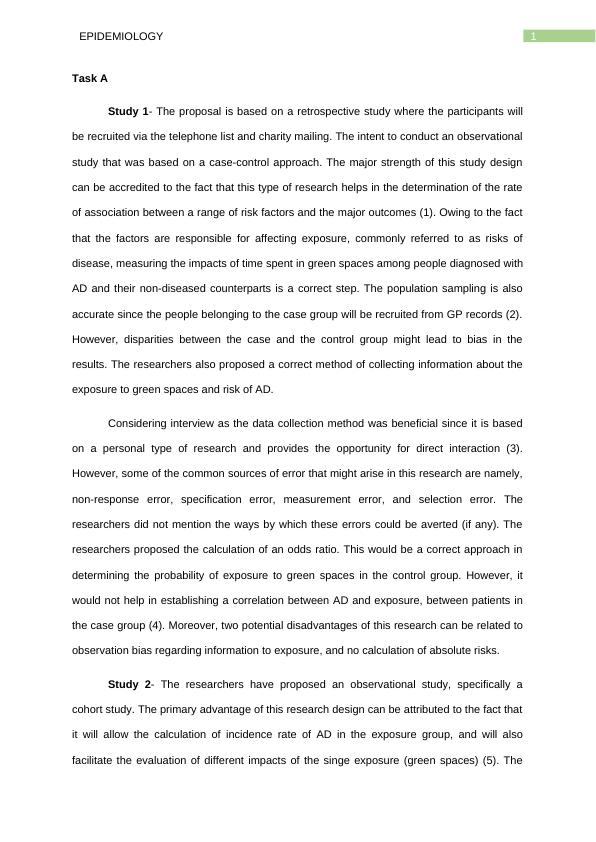Epidemiology: Observational Studies on Alzheimer's Disease and Green Spaces
Added on 2023-05-31
7 Pages1889 Words208 Views
Running head: EPIDEMIOLOGY
Task on epidemiology
Name of the Student
Name of the University
Author Note
Task on epidemiology
Name of the Student
Name of the University
Author Note

1EPIDEMIOLOGY
Task A
Study 1- The proposal is based on a retrospective study where the participants will
be recruited via the telephone list and charity mailing. The intent to conduct an observational
study that was based on a case-control approach. The major strength of this study design
can be accredited to the fact that this type of research helps in the determination of the rate
of association between a range of risk factors and the major outcomes (1). Owing to the fact
that the factors are responsible for affecting exposure, commonly referred to as risks of
disease, measuring the impacts of time spent in green spaces among people diagnosed with
AD and their non-diseased counterparts is a correct step. The population sampling is also
accurate since the people belonging to the case group will be recruited from GP records (2).
However, disparities between the case and the control group might lead to bias in the
results. The researchers also proposed a correct method of collecting information about the
exposure to green spaces and risk of AD.
Considering interview as the data collection method was beneficial since it is based
on a personal type of research and provides the opportunity for direct interaction (3).
However, some of the common sources of error that might arise in this research are namely,
non-response error, specification error, measurement error, and selection error. The
researchers did not mention the ways by which these errors could be averted (if any). The
researchers proposed the calculation of an odds ratio. This would be a correct approach in
determining the probability of exposure to green spaces in the control group. However, it
would not help in establishing a correlation between AD and exposure, between patients in
the case group (4). Moreover, two potential disadvantages of this research can be related to
observation bias regarding information to exposure, and no calculation of absolute risks.
Study 2- The researchers have proposed an observational study, specifically a
cohort study. The primary advantage of this research design can be attributed to the fact that
it will allow the calculation of incidence rate of AD in the exposure group, and will also
facilitate the evaluation of different impacts of the singe exposure (green spaces) (5). The
Task A
Study 1- The proposal is based on a retrospective study where the participants will
be recruited via the telephone list and charity mailing. The intent to conduct an observational
study that was based on a case-control approach. The major strength of this study design
can be accredited to the fact that this type of research helps in the determination of the rate
of association between a range of risk factors and the major outcomes (1). Owing to the fact
that the factors are responsible for affecting exposure, commonly referred to as risks of
disease, measuring the impacts of time spent in green spaces among people diagnosed with
AD and their non-diseased counterparts is a correct step. The population sampling is also
accurate since the people belonging to the case group will be recruited from GP records (2).
However, disparities between the case and the control group might lead to bias in the
results. The researchers also proposed a correct method of collecting information about the
exposure to green spaces and risk of AD.
Considering interview as the data collection method was beneficial since it is based
on a personal type of research and provides the opportunity for direct interaction (3).
However, some of the common sources of error that might arise in this research are namely,
non-response error, specification error, measurement error, and selection error. The
researchers did not mention the ways by which these errors could be averted (if any). The
researchers proposed the calculation of an odds ratio. This would be a correct approach in
determining the probability of exposure to green spaces in the control group. However, it
would not help in establishing a correlation between AD and exposure, between patients in
the case group (4). Moreover, two potential disadvantages of this research can be related to
observation bias regarding information to exposure, and no calculation of absolute risks.
Study 2- The researchers have proposed an observational study, specifically a
cohort study. The primary advantage of this research design can be attributed to the fact that
it will allow the calculation of incidence rate of AD in the exposure group, and will also
facilitate the evaluation of different impacts of the singe exposure (green spaces) (5). The

2EPIDEMIOLOGY
researchers have proposed use of a GPS tracking wristwatch that will allow them to keep a
track of the time spent in green spaces, and further determine its correlation with AD onset.
Conduction of a baseline assessment is another strength since it will help in the establishing
a point from which upcoming dimensions and calculations can be premeditated (6). Although
the researchers have proposed measuring the daily movement during each follow-up period,
the exact timeline of the study was not proposed. Rate ratio refers to the relative difference
measure that is used for comparing the event incidence rates that occur at a certain point of
time. The fact that the researchers have also cited the need of conducting cognitive and
mental state assessments for diagnosing AD among the recruited individuals is a correct
step.
However, conduction of blood tests is also essential for ruling out the possibility of
other dementia causes, apart from AD. Recruitment of a large sample size will increase the
reliability of the results, thus facilitating the detection of statistically significant changes in the
research (7). Although the researchers will adopt the strategy of purposive sampling that will
allow them with necessary justification for drawing generalisation from the larger sample, the
process can be greatly prone to researcher bias. The process might also lead to difficulty in
defending sample representativeness. However, some of the weaknesses of the proposed
study can be attributed to the fact that the researchers would have to follow a large number
of participants for a long period of time. Furthermore, the study will be time consuming and
expensive. Loss to follow-up refers to the participant who although actively contributed to the
research at a certain point of time, often get lost or unreachable during follow-up period (8).
Thus, differential loss to follow-up period might also result in introduction to bias.
Study 3- This study is another observational study that is based on cross-sectional
design and will analyse the data from a certain population at a specific point of time. The
major strength of this proposed research can be accredited to the fact that it will allow the
collection of large cross-sectional data at little expense (9). Furthermore, owing to the fat that
multiple variables will be considered during data snapshot, the findings can be analysed for
researchers have proposed use of a GPS tracking wristwatch that will allow them to keep a
track of the time spent in green spaces, and further determine its correlation with AD onset.
Conduction of a baseline assessment is another strength since it will help in the establishing
a point from which upcoming dimensions and calculations can be premeditated (6). Although
the researchers have proposed measuring the daily movement during each follow-up period,
the exact timeline of the study was not proposed. Rate ratio refers to the relative difference
measure that is used for comparing the event incidence rates that occur at a certain point of
time. The fact that the researchers have also cited the need of conducting cognitive and
mental state assessments for diagnosing AD among the recruited individuals is a correct
step.
However, conduction of blood tests is also essential for ruling out the possibility of
other dementia causes, apart from AD. Recruitment of a large sample size will increase the
reliability of the results, thus facilitating the detection of statistically significant changes in the
research (7). Although the researchers will adopt the strategy of purposive sampling that will
allow them with necessary justification for drawing generalisation from the larger sample, the
process can be greatly prone to researcher bias. The process might also lead to difficulty in
defending sample representativeness. However, some of the weaknesses of the proposed
study can be attributed to the fact that the researchers would have to follow a large number
of participants for a long period of time. Furthermore, the study will be time consuming and
expensive. Loss to follow-up refers to the participant who although actively contributed to the
research at a certain point of time, often get lost or unreachable during follow-up period (8).
Thus, differential loss to follow-up period might also result in introduction to bias.
Study 3- This study is another observational study that is based on cross-sectional
design and will analyse the data from a certain population at a specific point of time. The
major strength of this proposed research can be accredited to the fact that it will allow the
collection of large cross-sectional data at little expense (9). Furthermore, owing to the fat that
multiple variables will be considered during data snapshot, the findings can be analysed for

End of preview
Want to access all the pages? Upload your documents or become a member.
Related Documents
Sample Assignment on Epidemiologylg...
|10
|1463
|325
SPH 696 Epidemiology Methods Case Study 2022lg...
|10
|3083
|22
A Study on TH Concepts of Epidemiology.lg...
|9
|1458
|20
Research Process and Associated Biaseslg...
|4
|742
|102
Critical Appraisal Assignmentlg...
|21
|2827
|100
Epidemiology: Case-Control Study on Residential Greenness and Prostate Cancer Risklg...
|5
|930
|219
